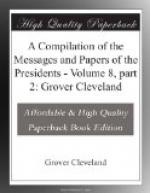The height of a part of the line explored by Captain Talcott in 1840, lying at the source of Arnolds River, was not determined for the want of a barometer.
Two or three miles in length of the line of highlands near the source of the river Du Loup require to be reexamined.
The longitudes of Lake Megantic, Lake Etchemin, the source of the Metjarmette, upon the line of Captain Talcott, and of some one point on the line of Professor Renwick ought to be ascertained with greater precision than the time that could be allowed during the last season would permit.
The instructions of Mr. Forsyth contemplated an exploration of the highlands described in the proclamation of 1763 as beginning on the north shore of the Bay of Chaleurs. The existence of a continuous elevated region from the tide of that bay to the termination of the exploring meridian line has been ascertained in a manner satisfactory to the commission, but the heights have not been measured on that part of it which lies nearest to the Bay of Chaleurs.
Under these circumstances the undersigned are of opinion that as no delay in the presentation of a final report will arise from further explorations of the parts of the territory thus pointed out and the more accurate examination of the uncertain matters, it would add to the confidence which may be placed in their results that a party be employed under the direction of each of the above-named commissioners upon the said work. For this object it is estimated—
1. That $25,000 in all, say $12,500 to be expended under the direction of each of the two above-named commissioners, will suffice. A less sum than this will not keep two parties in the field during the working season; a larger sum could not advantageously be expended on this part of the work.
2. In estimating the amount necessary for completing the delineation of the meridian of the source of the river St. Croix, it will be borne in mind that numerous astronomical observations must be made in aid of the operations with the transit instrument, in order constantly to preserve the true north direction, a condition of the utmost consequence, not alone as affecting the extent of territory that will be embraced by it, but more particularly because the character and position of the highlands alluded to in the treaty of 1783 would be exhibited in a very different light as encountered by a line running due north, as is required by the treaty, and by one varying even in a slight degree from that direction. This principle has already been exhibited in a striking manner by the trace of the meridian line as far as it has now progressed, for instead of encountering highlands in the latitude of Mars Hill having a claim to be considered those described in the treaty as the intended boundary between the two countries, the line as recently traced actually passes that latitude at an elevation of less than 10 feet above the level of the monument, and the greatest elevation encountered by this line in passing over any spur connected with Mars Hill is 63 feet above the level of the monument. In advance of this spur the line becomes again depressed below the level of the monument at several points before it reaches the Aroostook.




